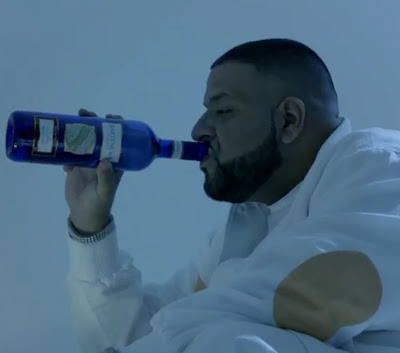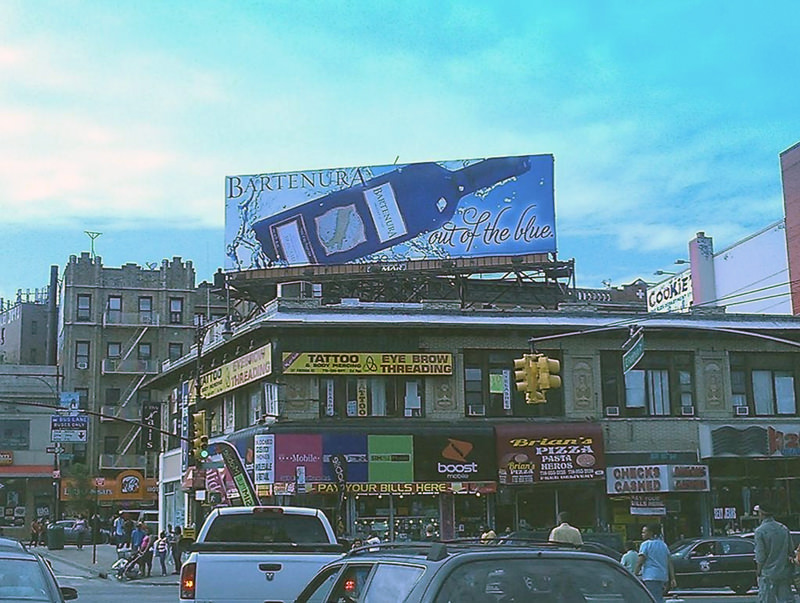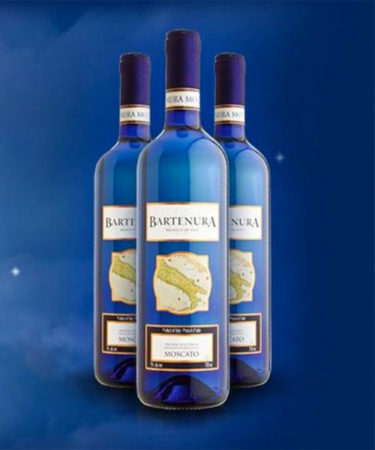If you grew up in the U.S. in the eighties and nineties, chances are you only came in contact with Bartenura Moscato if you also happened to live in a Jewish household. For many American Jews, Bartenura was that sweet kosher wine in the blue bottle that would often make an appearance at holiday gatherings and on random Friday nights. For Jews that didn’t even keep kosher, there was still most likely a familiarity with the wine, as culturally many Jews who wouldn’t normally serve kosher wine often felt compelled to do so at least during the major holidays such as Passover and Rosh Hashanah, which meant that around the close of these meals, the bottle would usually emerge and family members would pass it around the table.
For Jewish Americans, Bartenura Moscato was a nice change of pace from the other widely available kosher wines on the market, such as Mogen David and Manischewitz. Not only was it a white wine, but it was Italian, which allowed many Jews to feel as if there were other worldly options of kosher wine out there, when really, at the time, the options were quite limited. During this time, eighty-five to ninety-five percent of the wine’s consumers were Jews.
I can personally remember the first time my own family tasted the sweet wine at a Passover seder shortly after my Bar Mitzvah. We lived in a small town and a guest had brought the wine in from a large city a few hours away, having picked it up at the grocery store as one would any other kind of wine – which in and of itself was pretty amazing since my mom usually had to special order even Manischewitz. We were all amazed at the novelty of it, people were actually making kosher wine in Italy – Manischewitz came from upstate New York.
I remember it vividly because it was so different, it was smooth, sweet and slightly bubbly. For whatever reason, it didn’t seem to drink like normal kosher wine, the syrupy purple variety with flavors such as concord grape and blackberry that came in a large bottle closed with a screwcap and lasted the full year. The Moscato on the other hand was closed with a cork, and came in an alluring blue bottle. For whatever reason, all of that made the wine feel different, even special. For a few years after that, the bottle would make appearances at holidays, and we’d all have a little glass to close the meal.
Then at some point, my family and I moved on from Bartenura, but as we moved on, another population that wasn’t Jewish was fully embracing it and that embrace took Bartenura from its humble status as a small kosher wine, and turned it into the largest and most widely recognized Moscato brand on the American market. This year alone, thanks to celebrities like Drake and others in the Hip-Hop community, the company will sell four million bottles of the stuff.
Sydia Simmons is a Bartenura super-fan. A resident of Harlem, Simmons tells me Bartenura is the only brand of wine she’ll drink. “Bartenura’s my drink,” she tells me when we meet up to chat about her favorite beverage. “I discovered it a few years ago and now it’s the only wine I allow in my house.” Simmons is such a super-fan of the beverage that she’s even collected twenty-three empty bottles in order to make a wall clock out of them. “I’m going to place the clock over my stove in the kitchen, so you’ll always know it’s Bartenura time,” she says with glee.
Her friends love it too. “I always give the wine away at the charity events I run,” Simmons is an advocate for homeless mothers and their children, “and everyone loves how delicious it is. Lots of my friends even use it as a mixer.”
Simmons discovered the wine by accident, but the allure of the beverage had to do both with its sweetness – many kosher wines, especially those made using the Mevushal technique can be sweet – as well as the fact that it was kosher. “Knowing that the Moscato is kosher to me signifies that it’s purer than other wines,” says Simmons, “I know a lot of people haven’t been involved with making it, and as a pescetarian, I like feeling like my wine is also clean.” It turns out Bartenura also knows the fact the wine is kosher is part of its allure with their new market, “There is that perception that our wine is a bit better with the kosher certification on it, like hot dogs,” says Jay Buschbaum, Bartenura’s E.V.P. of Marketing.
How Bartenura went from a niche kosher product to becoming a worldwide phenomenon is a story of adept marketing, and taking advantage of an opportunity when it’s presented. In 2005, Lil’ Kim first rapped about her preference for the sweet wine when she said “Still over in Brazil sippin Moscato/ you must’ve forgot though/ so I’m a take it back to the block yo … ” With the popularity of the song and Kim, demand for Moscato began. At the time, there weren’t a ton of Moscatos on the market, and Bartenura was perfectly positioned to become the go-to bottle. “We saw rappers were talking about Moscato and identified the opportunity,” says Buschbaum, “we bit the bullet and decided to spend a fortune against marketing the product to fans of hip-hop, and the plan worked.”

Kim’s preference for Moscato was no fluke, and as more rappers began to rhyme about it, Bartenura Moscato began to fly off the shelves. Drake was the next to fully embrace and push the sweet wine in 2009 with his rhyme, “It’s a celebration/ clap clap bravo / lobster and shrimp / and a glass of Moscato … ” “I like to think that being raised Jewish, Drake probably came in contact with Bartenura as a kid,” Buschbaum says. Perhaps it was this initial exposure and the nostalgia he had for the wine that caused Drake to become a fan of the blue bottle in the first place, though he’s never said so publicly.
Another lucky twist of fate for the brand was that the wine was sold in the blue bottle to begin with. “I tell all my friends, just look for the blue bottle,” Simmons says, “I love how beautiful it is, the blue is really striking. Also, I try not to drink wine with my husband until my daughter goes to bed, since she’s young, but because it’s in a blue bottle, she has no idea it’s wine, so there’s an added benefit. We can have a glass or two if we want before bedtime.” The blue bottle also helps when it’s being sold in the club, where the wine is now a mainstay; it not only looks good, but it’s easy to ask for, even if you don’t remember the name, consumers just ask for the blue bottle.
“We actually almost killed that blue bottle in the ‘90s,” says Buschbaum, “we were running low and there were all of these issues with regulations and costs in terms of keeping the bottle’s blue hue. There was strong advocacy for just switching to the normal and affordable green, but there was nostalgia for keeping it blue, it’s what people remembered from their seders, I’m glad we did, as now there are several Moscato brands copying it.”
In all of Bartenura’s massive growth, the company continues to keep the wine kosher, even with the added cost, and besides small murmurs here and there, there’s been relatively little reaction among the brand’s original customers in terms of how the wine has grown and is now sold. One of the most interesting places to see the two consumers converge is in Crown Heights, where both African Americans and Orthodox Jews have lived in the neighborhood for decades. On a billboard in an area widely trafficked by both groups is an advertisement for Bartenura Blue, it’s very likely both groups think that ad is talking just to them, yet they are both the brand’s largest consumers. The non-Jews just probably don’t know the wine is named after a fifteenth century Italian scholar of Torah.

And while the consumption of Bartenura among the original Jewish consumers has leveled off in recent years, the growth of Bartenura has also served a much larger benefit to the community and that’s making kosher wine available in all those tiny towns that used to have to order it. “If you don’t have outside demand, it’s hard to stock a kosher wine in a small community,” says Buschbaum. Bartenura’s incredibly large and loyal following now helps solve that problem.
